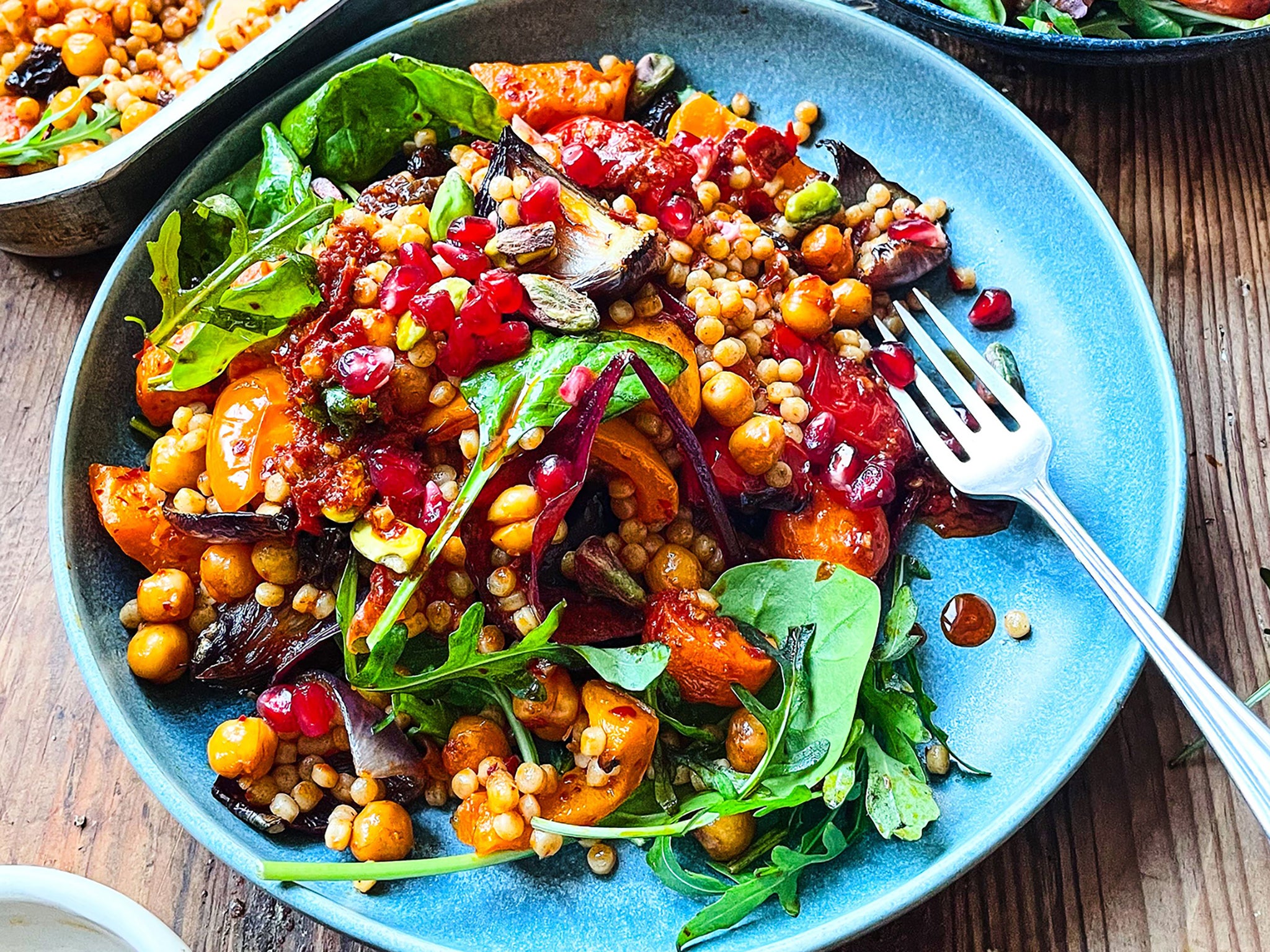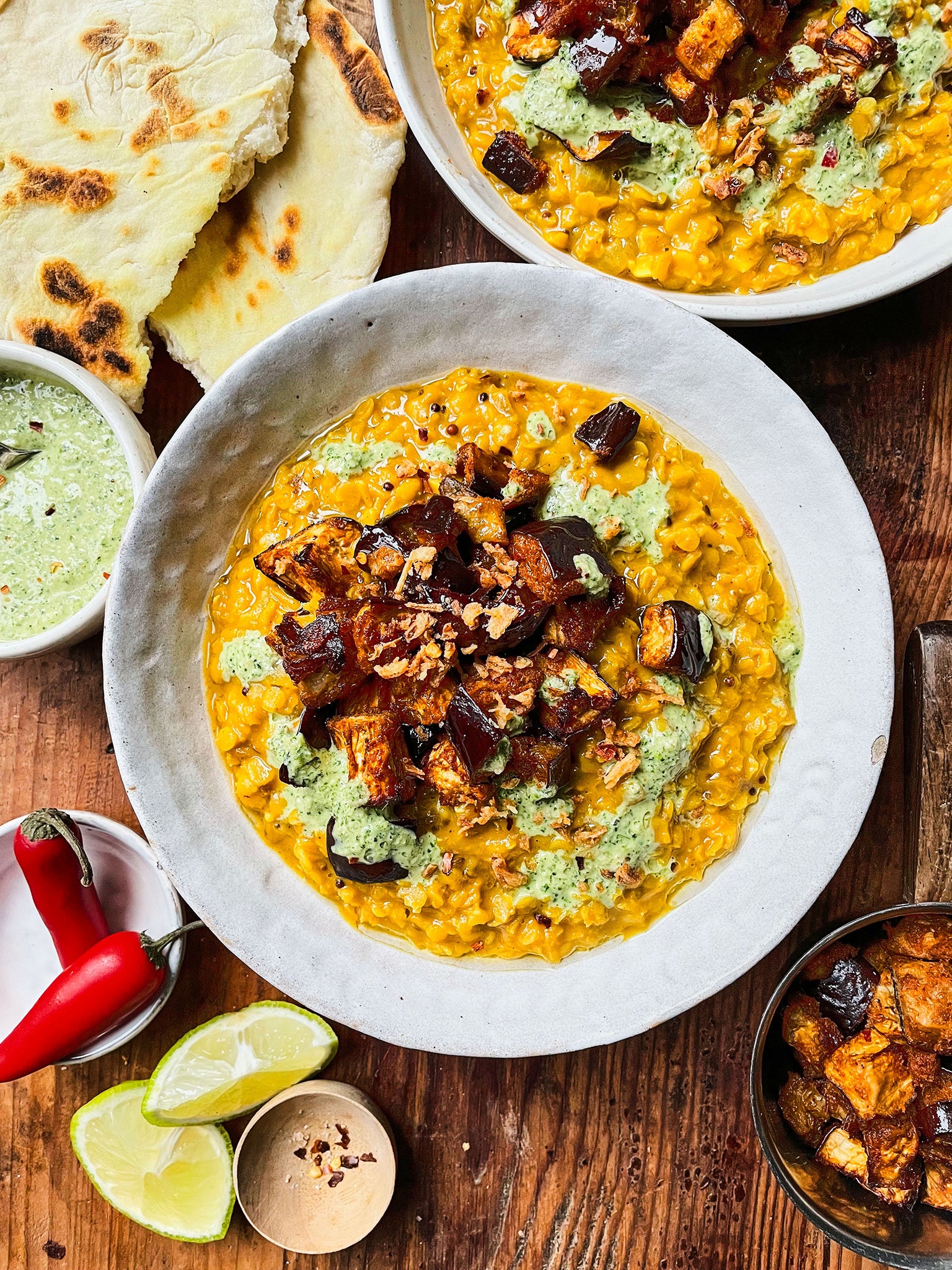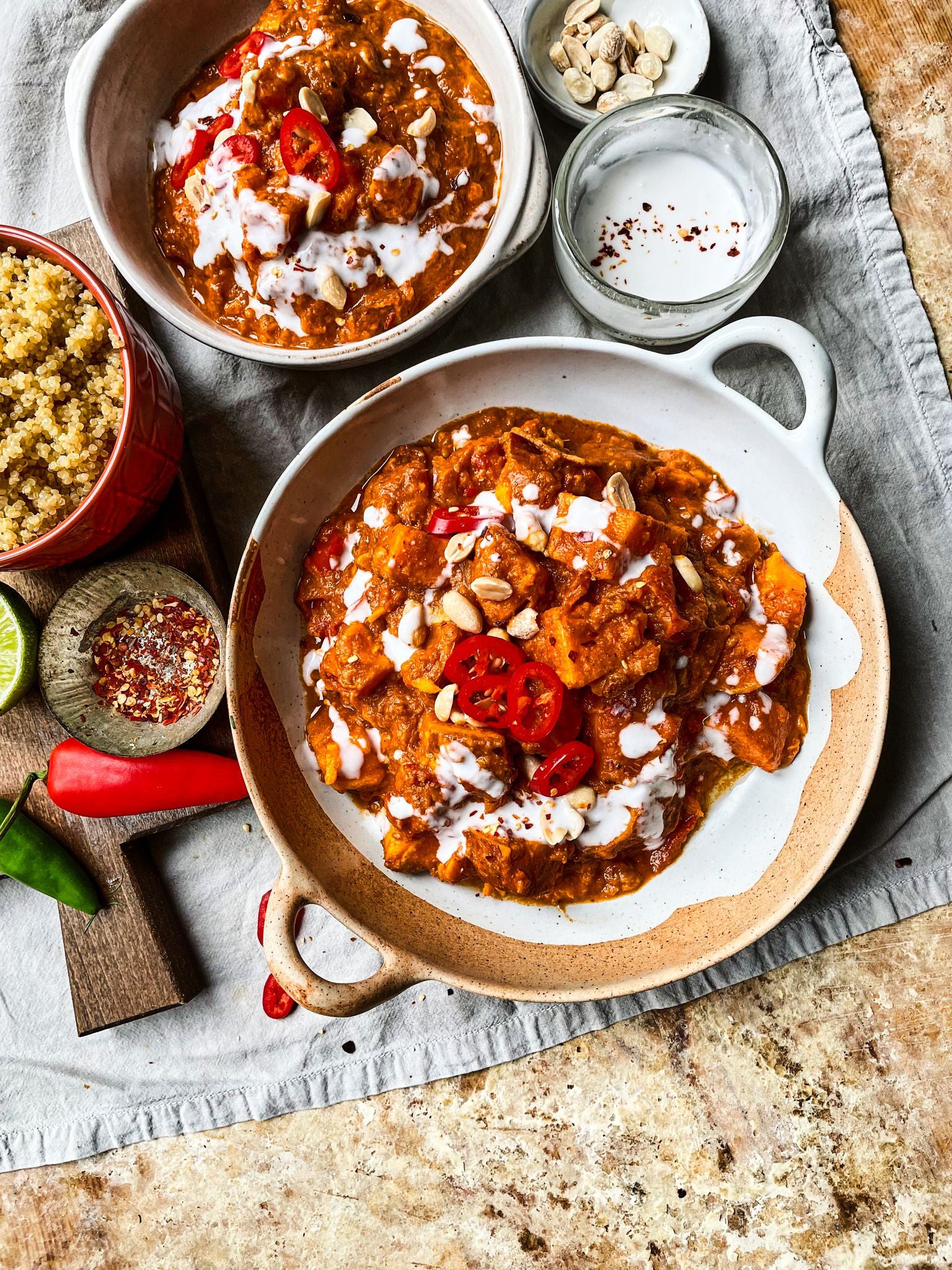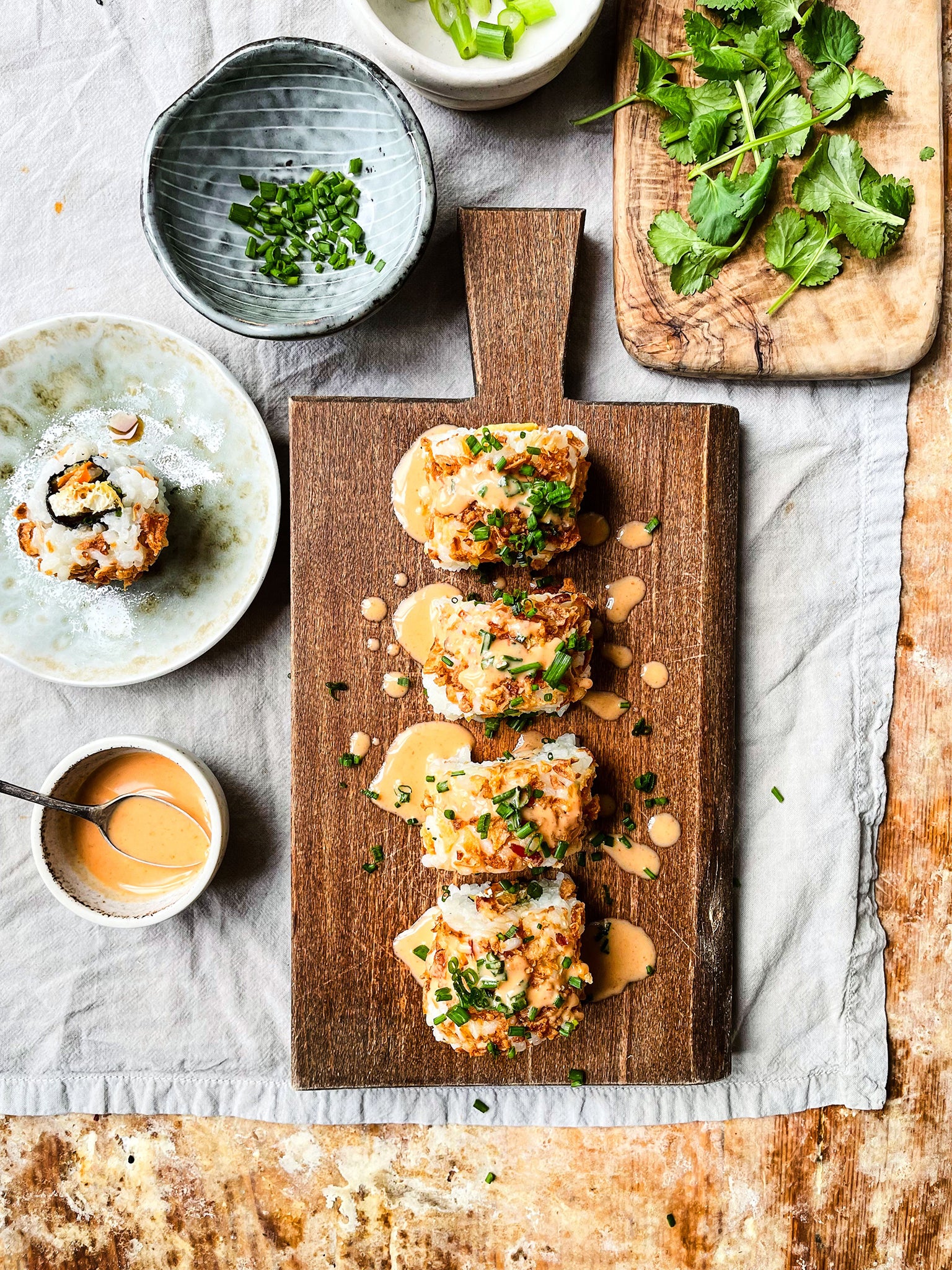Recipes and tips: the ingredients nutritionists swear by for healthy summer skin
As summer finally arrives, Veronika Prosek Charvatova’s guides us through the best food for skin health and explains why a diet packed with zinc, Vitamin E and beta-carotene is your best ally in achieving that sought-after glow


As the sun climbs higher and the days last longer, I start to think not just about how to enjoy the summer, but how to look and feel my best while doing so.
As a researcher at the UK’s top vegan charity, I’ve discovered the delicious pathway to achieving glowing summer skin through the power of food.
It’s all about incorporating beta-carotene, antioxidants, vitamin E and zinc – key nutrients that keep skin vibrant and healthy.
From a Moroccan salad rich in beta-carotene to an antioxidant-packed aubergine dhal, my recipes are designed not just for eating well, but for giving your skin a beautifying boost from within.
Ready to transform your diet and complexion? Let’s explore these colourful, nutrient-packed dishes that promise to enhance your summer glow.
Antioxidants
Brightly coloured foods such as fresh fruit and vegetables, turmeric, black and kidney beans, red lentils, pistachios, wild rice and black sesame are great for your skin as they supply a wealth of antioxidants.
As well as supporting your overall health, antioxidants also do wonders for the skin! They help protect skin cells from damage and tone down any inflammation. Many face creams and serums contain antioxidants but it’s much more effective to ensure a steady supply through your diet.
Antioxidant-rich foods also tend to be wholefoods and therefore provide plenty of essential nutrients but no nasties that would be bad for your skin.
To boost antioxidants in your diet, I recommend eating an aubergine dhal with coriander dip, which is packed with wholefoods including red lentils and turmeric. Lentils are also a brilliant source of fibre, which is good for gut microbiome.
Aubergine dhal with coriander dip

Ingredients:
For the aubergine:
1 large aubergine, cut into 2cm chunks
3 tbsp shop-bought vegan curry paste (optional)
Pinch of salt
For the dhal:
1 white onion, finely diced
6 fresh curry leaves (optional)
3 cloves garlic, finely chopped
Thumbnail of ginger, peeled and finely chopped
2 tsp cumin seeds
2 tsp ground coriander
1 tsp turmeric
1 tsp chilli powder
½ tsp ground fenugreek (optional)
½ tsp asafoetida (optional)
1 tbsp tomato purée or tamarind paste/concentrate
300g red lentils
825ml boiling water
1 x 400ml tin coconut milk
1½-2 tsp salt
¼ tsp black pepper
Juice of ½ a lemon
For the coriander dip:
100g fresh coriander, including stalks
Handful of mint leaves, stalks removed
100g unsalted peanuts or cashews, ideally toasted or roasted
2 small green chillies, deseeded
¼-½ tsp salt
¼ tsp turmeric
3 tbsp lemon juice
2 tsp brown sugar or syrup (eg maple or agave)
2 tbsp olive oil
6 tbsp vegan plain unsweetened yoghurt
Method:
For the aubergine:
1. Preheat the oven to 180C/350F/gas mark 4.
2. In a large bowl, mix the aubergine with the curry paste, a good glug of oil and a sprinkling of salt. Ensure that the aubergine is thoroughly and evenly coated.
3. Place the aubergine chunks on a baking tray in a single layer and evenly spaced, then place in the oven for around 25 minutes or until soft and lightly golden, turning once.
For the dhal:
1. While the aubergine chunks are in the oven, make the dhal.
2. Fry the onion and curry leaves in a little oil or vegan butter until golden.
3. Add the garlic, ginger and cumin seeds and fry for a further two minutes.
4. Stir through the other spices and fry for another two minutes.
5. Add the tomato purée, lentils, boiling water, coconut milk, salt and pepper. Bring to the boil then simmer on a medium heat for 25 minutes.
6. Add the lemon juice and heat for a further two minutes.
For the coriander dip:
1. Make the dip while the dhal is simmering.
2. Place all the ingredients in a high-speed blender and blend until very smooth.
To serve:
1. Divide the aubergine chunks into four portions and serve them on top of the dhal. Serve the coriander dip on the side or drizzle over the top.
Beta-carotene
Red, orange or yellow fruit and vegetables contain beta-carotene, the pigment responsible for those bright colours. Your body turns beta-carotene into vitamin A, which is essential for healthy skin, mucous membranes and vision. It is also an antioxidant and helps to protect your skin and combat inflammation. The best sources of vitamin A are carrots, pumpkins and squashes, tomatoes, red and orange peppers, sweet potatoes, apricots, peaches and nectarines, mango and cantaloupe melon and – perhaps surprisingly – green leafy veggies such as broccoli, kale, rocket and spinach.
To maximise beta-carotene levels, I recommend eating a Moroccan salad. The recipe uses peppers, carrots and sweet potato, all of which are excellent sources of beta-carotene.
Warm Moroccan salad with spicy harissa drizzle
Ingredients:
For the harissa dressing:
4 tbsp harissa paste (we like rose harissa)
6 tbsp olive oil
2 tbsp white wine vinegar
2 tsp syrup (eg maple or agave) or sugar
4 tbsp boiling water
For the salad:
2 red onions, peeled and quartered
2 red or yellow peppers, deseeded and cut into bite-sized chunks
2 sweet potatoes, peeled and cut into bite-sized chunks
2 large carrots, peeled and sliced into 2cm chunks
1 x 400g tin chickpeas, drained and rinsed
1-2 tsp cumin seeds
200g couscous, giant couscous, quinoa or bulgur wheat, cooked according to the instructions on the packet
2 handfuls of raisins, sultanas or chopped apricots (optional)
2 handfuls of blanched almonds, flaked almonds, pistachios or walnuts, ideally toasted or roasted
100g mixed leaves
Optional toppings: fresh coriander or mint, tahini sauce, pomegranate seeds, vegan plain yoghurt
Method:
For the harissa dressing:
1. Stir all the ingredients together in a small jug or mug until thoroughly combined. Set aside.
For the salad:
1. Preheat the oven to 200C/390F/gas mark 6.
2. Evenly space the onions, peppers, sweet potatoes and carrots on a large baking tray. Lightly coat in oil and a sprinkling of salt (you might want to get your hands in there!).
3. Place in the oven for 15 minutes then remove the tray, turn over the vegetables and add the chickpeas and cumin seeds to the tray.
4. Place back into the oven for 15 minutes or until the vegetables are golden and slightly caramelised.
5. In a large bowl, gently combine your chosen grain (eg giant couscous), roasted vegetables, chickpeas, raisins and nuts.
6. On a serving platter arrange the leaves, vegetables and grain mix and then top with the harissa dressing and other optional toppings.
Vitamin E
Your skin needs vitamin E to be healthy and resilient. It is a strong antioxidant that protects the skin cells and also helps your skin to heal.
You may have noticed that many face creams contain vitamin E and it’s not a coincidence but supplying it from within is far better because it has longer-lasting effects.
The best sources of vitamin E are almonds, sunflower seeds, hazelnuts, avocado, tomatoes, wheat germ and butternut squash.
For a vitamin E-boosting recipe, I recommend a Gambian peanut stew, which is made using both tomatoes and butternut squash for a double helping of vitamin E.
Gambian stew (domoda) with easy peanut hummus

Ingredients:
For the stew:
1 large onion, finely diced
2 red or green chillies, deseeded and finely sliced
4 cloves garlic, finely chopped
½-1 tsp chilli powder (depending on how much heat you like)
2 tsp ground cumin
6 large tomatoes, roughly chopped or use 1 x 400g/14 oz tin chopped tomatoes
200g/7 oz smooth peanut butter
3 tbsp tomato purée
800g/28 oz sweet potato, butternut squash or pumpkin, peeled and cut into 2cm cubes
800ml/3⅓ cup vegan stock
½ tsp salt
¼ tsp black pepper
Juice of ½ a lemon
For the easy peanut hummus:
1 x 400g/14 oz tin chickpeas, drained and rinsed
1 clove garlic, crushed
3 tbsp smooth peanut butter (use tahini if you’d rather make classic hummus)
2 tbsp olive oil
⅛ tsp ground cumin
Juice of 1 lime or ½ a lemon
½ tsp salt
¼ tsp black pepper
Method:
For the stew:
1. In a large non-stick pan or wok, fry the onion soft and golden.
2. Stir through the garlic, fresh chilli and cumin seeds (if using) and fry for a further two minutes.
3. If using ground cumin add here along with the chilli powder. Heat for a further minute.
4. Stir in the tomatoes, peanut butter, tomato puree and sweet potato before adding the stock.
5. Bring to a boil and then simmer for 35-45 minutes until reduced and thickened and the sweet potato is soft. Stir occasionally to make sure it doesn’t stick to the pan.
6. Stir through the lemon juice and cannellini beans/butter beans/chickpeas (if using) five minutes before the end of cooking time.
7. Taste the stew and add salt and pepper if necessary.
For the easy peanut hummus:
1. Using a high-speed blender or food processor, blend all of the ingredients until smooth.
2. Serve on the side of the stew with any of the optional serving suggestions below.
Serving suggestions: brown rice, chapatis, crushed peanuts, crusty bread, fresh chilli peppers (remove the seeds for less heat or fry first), fried kale, garlic bread, hummus, leafy green salad, mixed seeds, quinoa, roasted or steamed vegetables, vegan plain yoghurt.
Zinc
Zinc is a mineral often added to skin treatments because it helps your skin to heal. It’s also essential for making new cells and for the immune system in its daily fight against dangerous invaders.
A steady supply of zinc is just as important for your skin health as it is for your immune system. The best sources include pumpkin seeds, sesame seeds and tahini, tofu, tempeh, lentils and wholegrains.
I swear by this sushi dragon roll with spicy tahini sauce. It features tofu and tahini, both excellent sources of zinc.
Sushi dragon roll with spicy tahini sauce

Serves: 2
Prep time: 20 minutes | Cooking time: 25 minutes
Level: not too tricky
Ingredients:
For the rice:
130g sushi rice
350ml water
1 tbsp rice vinegar
1 tbsp sugar
½ tsp salt
For the spicy tahini sauce:
½ clove garlic, roughly chopped
3 tbsp lemon juice
2 tbsp tahini
½ tbsp olive oil
1½-2 tbsp water
1 tbsp sriracha
1 tsp syrup (eg maple or agave)
Pinch of salt
For the sushi:
1 large sheet toasted nori, cut in half lengthways
½ carrot, peeled and cut into thin sticks
¼ cucumber, cut into thin sticks
½ avocado, finely sliced
80g deep-fried tofu puffs or smoked tofu, finely sliced
50g crispy fried onions
20g fresh chives, finely chopped
2 tbsp soy sauce
Method:
For the rice:
1. Using a medium-sized saucepan, wash the sushi rice three times, drain it thoroughly, add the 350ml water and then leave it to sit for 30 minutes (if you don't have time to leave it to sit, go ahead and cook straight away).
2. Place the saucepan of rice and water on the stove, bring to a boil, cover with a lid and then simmer for around 20 minutes or until the water has absorbed, checking occasionally.
3. In a mug, mix together the rice vinegar, sugar and salt and then pour it over the rice, mixing thoroughly. Set aside to cool to room temperature.
For the spicy tahini sauce:
1. Using a mug or jug mix all the ingredients together until smooth. Set aside.
For the sushi:
1. Ideally use a bamboo mat but if you don't have one you can use a sheet of greaseproof paper, cut a little bit bigger than the halved nori sheets.
2. Place a half sheet of nori, shiny side down, on the bamboo mat.
Spread and cover the nori sheet with half the sushi rice. Press down firmly. Sprinkle with half the fried onions.
3. Flip the sheet over so the nori is on top and press down firmly again to help stick the fried onions to the rice. Place half the carrot, cucumber, avocado, tofu and a sprinkling of some of the chopped chives along the centre of the nori.
4. Roll the sushi into a cylindrical shape, packing it down tightly as you go. Cut into six even pieces.
5. Sprinkle the remaining chives (leaving half for the next roll) over the top. Drizzle over one tablespoon of the soy sauce followed by half of the spicy tahini sauce.
6. Repeat these steps to make the second dragon roll.
These recipes have been extracted from Everyone Can Cook Vegan, published by the UK’s leading vegan charity Viva!





Join our commenting forum
Join thought-provoking conversations, follow other Independent readers and see their replies
1Comments